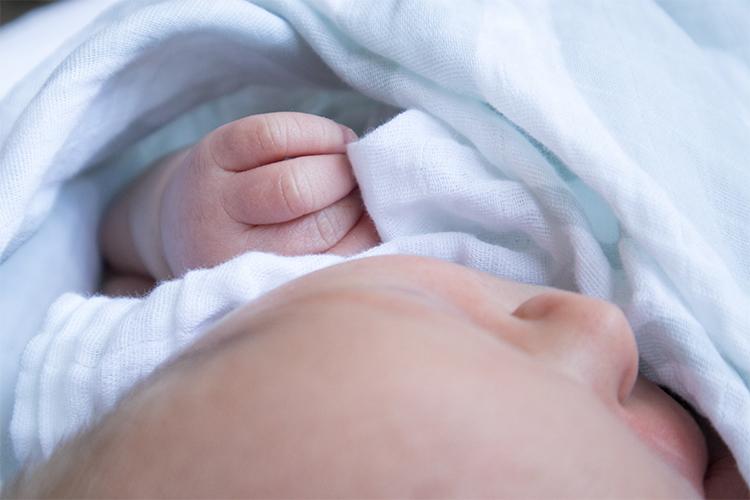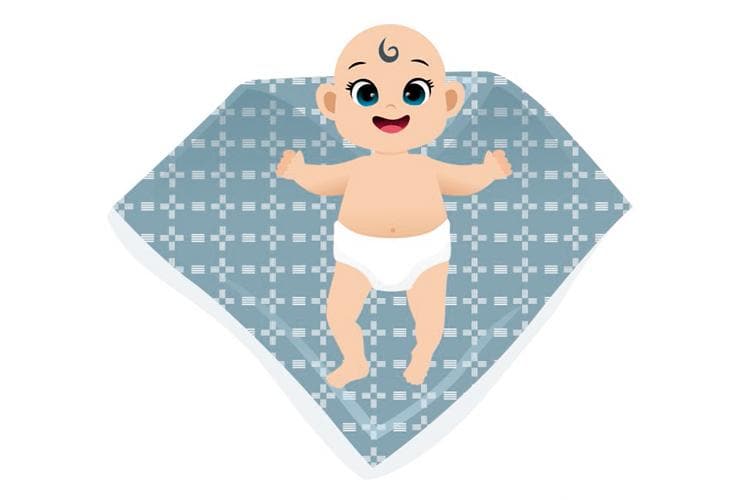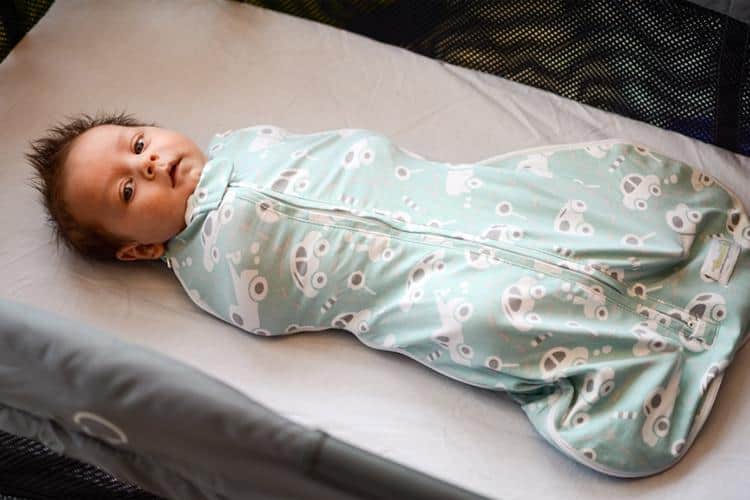Swaddling has been a common practice for years and years. In ancient civilizations, swaddling was a common practice. It was believed to help keep infants warm, restrict movement (which was thought to prevent injury), and promote better sleep. Historical records show swaddling was practiced in ancient Egypt, Greece, and Rome. So, what’s the best way to swaddle a baby, and what should parents know beforehand?
Below, we’ll cover the most critical information parents should know before swaddling their baby for the first time. This includes why parents should consider baby swaddling and what benefits swaddling offers to babies and parents. In addition, we’ll share a step-by-step guide to swaddling, alternatives to traditional baby swaddling, and recognizing when it’s time to stop swaddling. With this guide, you’ll be on your way to swaddling your little one safely and beneficially.
The Science Behind Swaddling: Why Swaddle?

Photo: Tim Bish
Swaddling is the closest thing to simulating how a baby felt when they were in utero. A swaddling blanket recreates containment, comfort, and restrictive movement while keeping baby warm. Just as the baby could not move their arms and legs around much in the womb, a good swaddle restricts their movement similarly.
Some parents have heard that baby swaddling an infant baby can help reduce the risk of SIDS or Sudden Infant Death Syndrome. But, according to an article published in the AFP Journal, “no data exist on the use of swaddling for lowering the risk of SIDS.”
The Benefits of Swaddling Your Baby

Photo: Ryan Stone
Swaddling a baby doesn’t just help them feel secure and reminds them of when they lived inside the womb. Swaddling also provides benefits to baby, such as improving their sleep, making nursing more effortless, and reducing colic. Let’s dive into each of these benefits more below.
Improves sleep
Babies make quick movements at night and startle themselves awake as their arms or legs move about. If they are swaddled, the arms and legs cannot quickly move, preventing startle reflux.
Makes nursing easier
Baby swaddling helps keep baby’s arms down, allowing Mom to get a better latch when nursing.
Reduces colic
According to the Mayo Clinic, swaddling can help reduce colic in a baby since it is soothing and comforting.
The Right Time to Start Swaddling

Photo: Kelly Sikkema
Most of the time, babies can begin to be swaddled right after birth. Doctors and birthing centers typically swaddle baby for Mom or demonstrate to Mom how to swaddle their little one properly and safely. Whether or not the baby will enjoy being swaddled is another story. You will know if your baby doesn’t prefer to be swaddled if they show discomfort or resistance when wrapped in a blanket. The truth is that some babies love the feeling, and some babies don’t like feeling restricted. Remember to be open to how your baby might react and flexible to adjust their sleep environment as needed.
Related:
- Newborn Sleep Schedules & Patterns Simplified
- Why Do Babies Cry?
- Essential Nursery Furniture: a New Parent Buying Guide
Choosing the Right Swaddle Blanket

Photo: thulatula.com
There are three main types of swaddle blankets: traditional swaddle blankets, sleep sacks, and baby swaddling blankets with zippers. Here are the differences between each type of swaddle blanket:
Traditional
Traditional swaddle blankets are often made from cotton or muslin fabrics, which are soft, lightweight, and breathable to help keep baby comfortable. These blankets are larger than typical baby blankets since there needs to be more fabric to wrap around baby effectively. Beyond swaddling a baby, traditional swaddle blankets can also be used as nursing covers, stroller covers, burp cloths, and more.
Sleep sacks
Unlike traditional swaddle blankets that must be wrapped around a baby to secure them, sleep sacks are more similar to clothing. When babies wear sleep sacks, their legs are fully covered and can move without restriction. Sleep sacks also give babies the freedom to move their arms around.
Swaddling blankets with zippers
A swaddling blanket with a zipper is similar to a sleep sack but tends to be more form-fitting around baby’s midsection and arms, unlike sleep sacks. These types of swaddling blankets usually cover baby’s hands entirely. They are easy to put baby in since the swaddle blanket is secured with a zipper.
Mastering the Art of Baby Swaddling: A Step-by-Step Guide

Photo: crane-baby.com
While there may be several ways to swaddle a baby, most parents use one primary technique with their little ones as it’s been proven to work quite well, and it doesn’t take long. Here’s how to properly and safely swaddle your baby in just six steps:
Step 1: Lay a square blanket on the ground so that it’s positioned to look like a diamond shape. The corner should be at the top.
Step 2: Fold the top corner of the blanket down so that it will be under baby’s back once you place them on the blanket.
Step 3: Hold baby’s right arm down and grab the right corner of the blanket to pull it over their body and tuck it behind them.
Step 4: Grab the bottom corner of the blanket, pull it up and over baby’s right shoulder, and tuck it behind them.
Step 5: Now, grab the left corner of the blanket, wrap it across the baby, and tuck it securely around the back of baby and into the blanket pocket you created for a snug fit.
Alternatives to Traditional Swaddling Techniques

Photo: babygearlab.com
There are options if your little one isn’t finding traditional baby swaddling comfortable or if you’d rather swaddle your baby with a more straightforward approach. Many parents love using wearable blankets such as swaddle suits or sleep sacks to keep their baby warm without restricting movement. Swaddle suits and sleep sacks are also great options for babies too large or moving too much to be swaddled traditionally. As you look for swaddle suits or sleep sacks to purchase, you will notice that these swaddles are often offered in many sizes, allowing your baby to utilize them from infancy to toddlerhood.
Swaddling Safety Guidelines: Do’s and Don’ts

Photo: parents.com
Before swaddling your baby for the first time, knowing how to do it properly and what to avoid doing it altogether is essential. First, you want to ensure that baby’s swaddle is not too tight. Even when swaddled, baby’s should be able to move their hips naturally. If the swaddle is too tight, this can cause hip dysplasia, which causes the hip joint to develop abnormally.
You also want to ensure that baby is breathing normally and that the swaddle is not too tight around the chest or near the face. Finally, while baby swaddling can help regulate your little one’s temperature, you don’t want them to get too hot. Feeling their skin and checking their appearance will help you monitor their body temperature.
Note: Parents can obtain more health information from the International Hip Dysplasia Institute.
Recognizing When to Stop Swaddling

Photo: takingcarababies.com
At some point, your baby will outgrow swaddling altogether, at least traditional swaddling with a blanket. Alternative baby swaddling with sleep sacks or swaddle suits can generally be used for a more extended period of time if they range in size from infant to toddler. With traditional swaddling, there are signs that your baby is ready to transition out of it. Look for signs such as:
Rolling over
Once your little one starts attempting to roll over, it’s time to stop swaddling them. Swaddling can pose a risk to your child if they roll over onto their stomach and cannot use their arms.
Breaking out of the swaddle
When your baby starts breaking out of their swaddle or looking uncomfortable, you’ll know the swaddling phase is over.
Discomfort
Swaddling is not for everyone, so you should stop swaddling if you notice your baby looking uncomfortable or experiencing discomfort.
Age
In general, babies around 2 to 4 months of age will start to show signs that they’re ready to have more flexibility in moving around.
Myths and Misconceptions about Swaddling

Photo: wonderbaby.org
Here are a few myths and misconceptions about baby swaddling that parents should be aware of regarding safe swaddling and safe sleep practices:
Swaddling prevents SIDS
As mentioned above, insufficient evidence supports this claim to ensure safe infant sleeping.
Swaddling is necessary in infancy
Not true! Swaddling is simply your baby’s preference. They may or may not enjoy swaddling.
Swaddling can be done with any blanket
Blankets used for swaddling should be lightweight and breathable. A thick or warm blanket will increase baby’s body temperature and could cause them to overheat.
Swaddling can be done tightly
While a swaddle blanket is not necessarily loose, it should be flexible enough to allow baby to move their hips and not disrupt breathing.
Conclusion
To wrap up, baby swaddling can be a helpful tool in providing comfort to your little one and, in most cases, can begin as soon as infancy. The act of swaddling may reduce colic and make it easier to breastfeed, in addition to improving sleep. Parents can choose to traditionally swaddle their baby or pick from an alternative swaddling method like using a sleep sack or sleep suit.
If traditionally swaddling, follow the step-by-step guide so that baby is comfortable, doesn’t get too hot, and can still move their hips around to avoid hip dysplasia. Finally, it’s essential to know what signs to look for that will tell you when to stop swaddling altogether. Hopefully, with this complete guide to baby swaddling, you will feel confident in caring for your little one in this way. Happy parenting!
Frequently Asked Questions
What are the benefits of swaddling my baby?
Benefits of swaddling your baby include improving their sleep, soothing the baby, reducing anxiety, and preventing baby from scratching themselves. Swaddling also helps regulate baby’s temperature by keeping them warm throughout the night.
How can I choose the right swaddle blanket?
When choosing the best swaddle blanket for your baby, you should consider the material, size, design, and how easy it is to use it. Swaddle blankets are typically made of breathable and lightweight materials so that baby does not overheat or feel uncomfortable. New parents may prefer swaddle blankets with closures or built-in guidance to make swaddling easy.
How can I know when to stop swaddling?
Once your baby starts trying to roll from back to front or front to back, it’s time to stop swaddling them. Another way you will know that it’s time to stop swaddling your baby is when they begin breaking out of their swaddle.
What are some common myths and misconceptions about swaddling?
Some of the most common misconceptions about swaddling are that all babies must be swaddled, swaddling should be tight, and that swaddling will prevent baby from crying.

Morgan French is a wife, mom of two, writer & editor. After traveling for 3 years with her family, she now lives back in her hometown of Dayton, OH. She makes frequent stops for coffee, enjoys the outdoors, and loves board games.



Leave A Comment